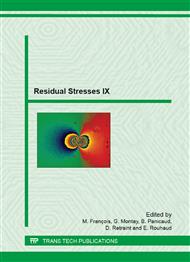[1]
Atlas of Wheel and Rail Defects: A Report Commissioned by the Steering Group of UIC/WEC Joint Research Project 2 - Wheel/Rail Interface Optimization, International Union of Railways, UIC, (2004).
Google Scholar
[2]
W. Zhong, J.J. Hu, Z.B. Li, Q.Y. Liu, Z.R. Zhou, A study of rolling contact fatigue crack growth in U75V and U71Mn rails, Wear. 271 (2011) 388-392.
DOI: 10.1016/j.wear.2010.10.071
Google Scholar
[3]
W.J. Wang, H.M. Guo, X. Du, J. Guo, Q.Y. Liu, M.H. Zhu, Investigation on the damage mechanism and prevention of heavy-haul railway rail, Engineering Failure Analysis. 35 (2013) 206-218.
DOI: 10.1016/j.engfailanal.2013.01.033
Google Scholar
[4]
A. Ekberg, E. Kabo, Fatigue of railway wheels and rails under rolling contact and thermal loading - an overview, Wear. 258 (2005) 1288-1300.
DOI: 10.1016/j.wear.2004.03.039
Google Scholar
[5]
D.F.C. Peixoto, L.A.A. Ferreira, Fatigue crack propagation behavior in railway steels, International Journal of Structural Integrity. 4, 4 (2013) 487-500.
DOI: 10.1108/ijsi-10-2012-0029
Google Scholar
[6]
A.A.L. Rego, D.F.C. Peixoto, L.A.A. Ferreira, Rolling contact fatigue tests in a twin disc machine, Proceedings of IBERTRIB 2011, VI Iberian Congress on Tribology, Madrid, Spain, 16-17 June. (2011).
Google Scholar
[7]
K.L. Johnson, Contact Mechanics, Cambridge University Press, Cambridge, (1985).
Google Scholar
[8]
E.V. Zaretsky, R.J. Parker, W.J. Anderson, A Study of Residual Stress Induced During Rolling, Journal of Tribology. 91, 2 (1969) 314-318.
DOI: 10.1115/1.3554921
Google Scholar
[9]
H. Muro, N. Tsushima, K. Nunome, Failure analysis of rolling bearings by X-ray measurement of residual stress, Wear. 25, 3 (1973) 345–356.
DOI: 10.1016/0043-1648(73)90005-7
Google Scholar
[10]
A.P. Voskamp, R. Österlund, P.C. Becker, O. Vingsbo, Gradual changes in residual stress and microstructure during contact fatigue in ball bearings, Metals Technology. 7 (1980) 14–21.
DOI: 10.1179/030716980803286676
Google Scholar
[11]
A.P. Voskamp, E.J. Mittemeijer, State of residual stress induced by cyclic rolling contact loading, Materials Science and Technology. 13, 5 (1997) 430-438.
DOI: 10.1179/mst.1997.13.5.430
Google Scholar
[12]
R. C. Dommarco, K. J. Kozaczek, P. C. Bastias, G. T. Hahn, and C. A. Rubin, Residual stresses and retained austenite evolution in SAE 52100 steel under non-ideal rolling contact loading, Wear. 257, 11 (2004) 1081-1088.
DOI: 10.1016/j.wear.2004.01.020
Google Scholar
[13]
L. Coelho, A.M. Dias, H.P. Lieurade, H. Maitournam, Experimental and Numerical Rolling Contact Fatigue Study on the 32 CrMoV 13 Steel, Fatigue Fract Engng. Mater. Struct., 27 (2004) 811-823.
DOI: 10.1111/j.1460-2695.2004.00797.x
Google Scholar
[14]
B. Allison, G. Subhash, N. Arakere, D.A. Haluck, H. Chin, Influence of Initial Residual Stress on Material Properties of Bearing Steel During Rolling Contact Fatigue, Tribology Transactions. 57 (2014) 533-545.
DOI: 10.1080/10402004.2014.881582
Google Scholar


